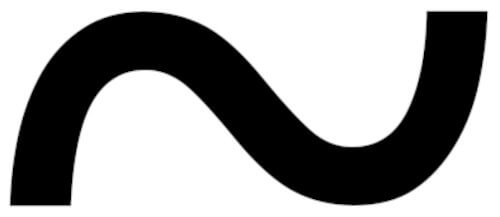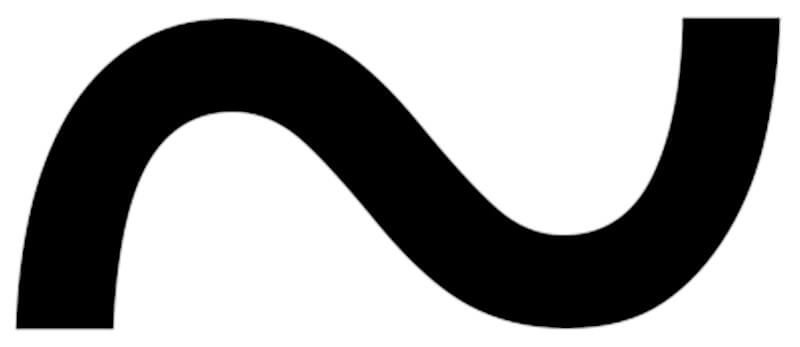Let’s discuss that little squiggly line. It’s the sign above the backquote (~), and it indicates approximation.
Maybe you use it in your online work or see it in a newspaper (maybe when polling public opinion about something). Or maybe you’ve never encountered it.
It’s called an “aspirational” or “tilde” notation, and in computer usage, the tilde sign stands for “approximately equal to,” or, more often these days: approximately.”
History of the Squiggly Line
A squiggly line is a wavy symbol ( ~ ) often found over a letter. Interestingly, the symbol has a name: the tilde.
Around the 12th century, Spanish scribes began using a squiggly line over letters to indicate they were doubled to use less paper.
Around 1522, this practice became specific to indicate only an “n” was being doubled. That remained the case until 1918 when the Spanish alphabet was reformed, and the ñ (used for all instances of “n” doubling in some languages) became an official character.

What Does a Squiggly Line Mean in Text?
You could replace the squiggly line with the word ‘about’ or ‘approximately.’ It means almost the same, just with more syllables. It’s also much harder to type.
But if you’re a cool, contemporary teenager, squiggly lines convey the desired impression of a tilde in a tone far better than the scarily old-fashioned ‘about’ or ‘approximately’ do.
What Does A Squiggly Line Mean In Math?
In math, a squiggly line commonly referred to as “?” often appears in equations. This symbol indicates that one number is approximately equal to another. It’s important to note that the approximation defined by this symbol is reflexive and symmetric but not transitive.
In other words, it differs from the symbols typically used for negation in logic or similar applications. Understanding the significance of “?” in mathematics can be crucial for thoroughly comprehending mathematical equations.
What Does a Squiggly Line Mean in Music?
The line in music notation for an arpeggio is squiggly in front of the chord. It indicates that notes of the chord are played rapidly one after the other instead of simultaneously (like in a strummed chord).
The length and direction of the squiggle determine how fast or slow each note will be.
What Does a Squiggly Line Mean in Organic Chemistry?
In organic chemistry, a wavy line symbol is a vital tool for representing complex molecules. This symbol indicates that structural changes may occur on one side of the equation that is either unknown to the scientist or not essential for further understanding.
For example, scientists can use this squiggly line symbol to denote a mixture without drawing out each isomer when studying mixtures of isomers. It’s an incredibly useful shorthand way of denoting complicated and connected chemical reactions so researchers can focus more closely on what they need to understand to make scientific discoveries.
How to Make the n With the Squiggly Line Over it on a Macbook?
A squiggly line or a tilde (~) above the letter n is called an “overline” in typography. Despite its name, this symbol has nothing to do with the letter o — it’s just a sideways squiggle on top of a lowercase n.
It can be confusing that there are two completely different ways to generate a ~ over the letter n. The squiggly-line symbol is used mainly in mathematics but can also be used as a special character in word processing programs or text editors (especially under Unix).
To type this symbol on your Mac, hold down the “option” key and press the “n” key. A tilde should appear “˜”. Next, type a lowercase “n”. Instead of the tilde “˜” and the lowercase “n”, you should see the letter ñ. If you type an uppercase “N” instead, you should see the letter Ñ.
Quick reference key combination:
Alt/Option key + n, and then the letter n againHow to Make the n With the Squiggly Line Over it on a Windows?
To type this symbol on your PC, hold down the “Ctrl” key, “Shift” key, and tilde “~” key all at the same time. Afterward, type the lowercase “n” key. You should see the letter ñ.
Quick reference key combination:
Ctrl key + Shift key + ~, and then the letter nOn an iOS Device such as iPhone and iPad
Open your favorite messaging app. When the keyboard on your device appears, press and hold down the letter “n.” After a second, a bubble should appear above the letter “n.” Slide your finger to the ñ. If you remove your finger from the keyboard, the bubble will disappear. You will have to slide your finger across to the ñ to select it.
If you want the capital letter “N,” use the Up Arrow and press and hold the letter “N.” Same as before, a bubble should appear above the letter “N.” Slide your finger to the Ñ.
Frequently Asked Questions
What Is The Squiggly Thing Called?
The tilde often referred to as the squiggly or twiddle, is an important yet often overlooked character on most keyboards. Found just below the escape key, the tilde appears with a few strokes of a key to create a squiggly line (~).
It can be used to denote certain words, to abbreviate letters and phrases in certain languages such as Portuguese, Spanish or Mexican Spanish, or even inserted in computer commands. Utilizing this versatile character can add flair or elegance to a typed piece while making it exciting and identifiable.
What Does The Squiggly Dash Mean?
The squiggly dash is a handy punctuation mark that one might not be aware of. It has become widely used in informal settings to inform people that a number is an estimation or approximation.
For example, if you are telling your mom about how many cats you saw in the park–you can say something like, “I saw ~10 cats,” and she will understand that it was around 10 cats; rather than giving her an exact figure which may not necessarily be true.
What Does ? Mean In Text?
Using the tilde symbol (~) in informal writing is becoming increasingly popular, especially online. It is often used to indicate that a number or quantity is approximate and not exact, such as when estimating a pet’s weight.
This practice can be traced back to its usage in mathematics, where the tilde sign indicates an equivalency or approximation. While it may take someone unfamiliar with this convention a few moments to figure out what it stands for, using this convenient symbol can be a great way to communicate quickly and unambiguously in writing.
Conclusion
The tilde, also known as the squiggly line, is a symbol used in various fields, including computer usage, math, music, and organic chemistry. In computer usage and text, it stands for “approximately equal to” or “approximately.” In math, it indicates that one number is approximately equal to another.
Music appears in front of a chord and indicates that the notes should be played rapidly one after the other. Organic chemistry represents structural changes or denotes a mixture without drawing out each isomer. The tilde can be typed on a Mac or PC using a specific key combination.






